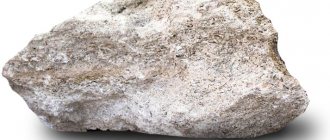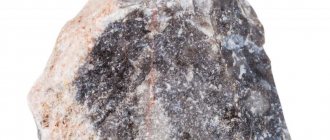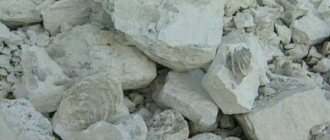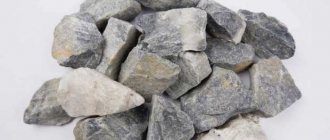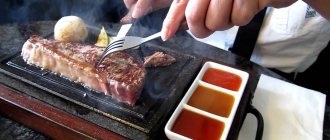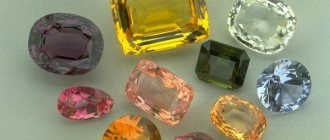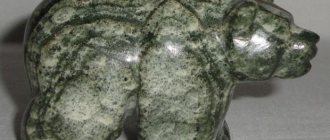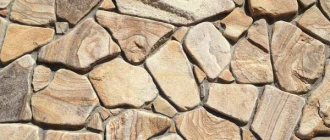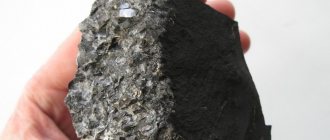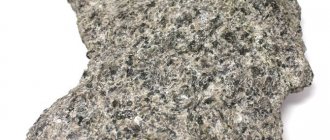Limestone is classified as a rock of sedimentary origin. It is a mixture of calcium carbonate with various impurities. In addition to clay and silicon, it may even contain the skeletons of microorganisms and the shells of marine animals. Despite the wide distribution of this material, it can not be found everywhere.
In Russia there are many deposits, but in Australia there are none at all. It is not for nothing that since the times of Ancient Rus', limestone has been considered one of the main building materials.
This is largely due to the fact that some architectural monuments of antiquity still stand to this day. The difference between limestone is that its layers are constantly being formed, which makes it virtually inexhaustible.
The concept of limestone, its chemical formula, what it looks like in the photo
Limestone is a sedimentary mineral of organic or chemogenic origin. It is characterized by a maximum content of calcium carbonate (CaCO3), which is presented in the form of calcite crystals of different sizes. If you examine the material at high magnification under a microscope, you can find impurities of phosphates, silicon, sand and clay particles, and the remains of shells of ancient microorganisms. The chemical formula of limestone, which contains dolomite, is CaMg(CO3)2. The admixture makes the material strong and dense.
The photo shows that the mineral can look different. The rock composed of shells (shell rock) has a fine-grained structure, while its relative chalk has a fine-grained structure. Chalk, marble, stones with inclusions of round shells (nummulitic limestones) are all varieties of limestone. What color is the mineral? The picture shows that it is naturally white. Impurities and their combinations give the mineral unique shades.
Properties and technical specifications
The chemical composition of limestone includes a large number of impurities, but the bulk of it is calcite, which is better known as calcium carbonate. Its formula is CaCO3. To avoid confusion, it is assumed that limestone has the same formula.
Among the characteristics of the material, the following occupy an important place: density, hardness and elastic modulus.
According to GOSTs, these characteristics can take the following values:
- Density: 2700-2900 kg/m3;
- Hardness: 800-2800 kg/m3. The softest are travertines and shell rocks, and the hardest are crystalline limestones;
- Elastic modulus: 0.4-300 MPa.
In general, limestones are not very hard. They are easy to scratch with a regular knife. GOSTs also provide for the rules for its storage and delivery.
Characteristics and origin of calcareous mineral
Natural stone limestone is a non-solid sedimentary rock with a maximum content of calcite. The rest of the mineral mass consists of inclusions of particles of other substances (silicon, phosphates, quartz, lime, etc.). Microparticles of the skeletons of simple organisms can also be found in the mass of calcium carbonate. The origin is generally characterized as organic, but there is also an organo-chemical path to the formation of the mineral.
The limestone mineral is mainly formed in the shallow water environment of the sea basin.
Freshwater conditions also allow limestone to be deposited. Its usual form of occurrence is a layer. It can be deposited according to the principle of salt: during the evaporation of water from lakes and lagoons. But the bulk of the stone originated precisely in the depths of the sea, where there were no intense processes of evaporation and drying.
The natural mechanism of mineral formation begins with the work of living organisms. They extract calcite from seawater and build shells. Then the remains of their skeletons accumulate on the bottom surface in a huge mass. The most significant example of the formation of calcite carbonate is the birth, growth and death of coral reefs. It is not uncommon for piece shells to be found on a fracture in a calcareous rock. This variety is called shell rock.
Other species are also named according to the types of organisms and their metabolic products:
- nummulitic;
- bryozoan;
- oolitic.
Marble-like limestone is a separate category. It, in turn, is divided into massively layered and thin-layered types. Under the influence of certain temperatures and pressure, it changes the structure of the crystals and is transformed into marble.
History and origin of the breed
Limestone was used in ancient times. The Greeks built temples of the gods from it. In Egypt, the pyramid of Cheops was laid out with hewn monoliths. In Russia and Malta, buildings and cathedrals were erected from it. Archaeologists have found many stone figurines, stucco moldings, and interior items.
Limestone requires sedimentary rock to form. It appears in two ways. In the first case, this is the precipitation of substances from hot solutions, for example near thermal springs. Petrification occurs during the cooling process.
In the second option, the remains of fish skeletons, mollusk shells, and other organic elements settle to the bottom. The thickness of the water contributes to their compaction and subsequent hardening.
This sedimentary rock is also called rock. The explanation is simple: subsidence occurs over a long period of time over a large area. The result is massive strata containing various fossilized minerals. Sediments change the bottom topography, forming hills. After the ancient seas dried up, mountains with sedimentary rocks were left on the earth, where limestone was first found.
Well-known “relatives” of the mineral are marble and soda ash.
The first is formed during the process of metamorphosis, which caused the recrystallization of limestone. The second deposit contains sodium
How is it formed in nature, where is it mined?
The limestone rock appears in the seas from the shells of mollusks, algae, corals and other inhabitants of sea waters. To build shells, some sea inhabitants require calcite, the source of which is water. The remains of tiny creatures accumulate at the bottom and are cemented under water pressure. They can be held together and saturated with minerals by solutions and gas streams that seep through the bottom.
Freshwater conditions also allow rock to be deposited. It can be deposited as lakes and lagoons evaporate. A separate category is marble-like limestone, which under the influence of temperatures and high pressure becomes hard and dense.
The usual form of rock occurrence is a layer. The method of its extraction depends on the location, age and type of limestone. It is extracted in an open way, after preliminary development of the quarry. To do this, the top layer of soil and clay is removed, then pyrotechnic work is carried out, which makes it possible to crush limestone and detach portions of stone. Next, the material is loaded into machines and taken out for processing.
Initially, when mining, people used the breaking method - the material was removed with crowbars and the layers were knocked out using hammers. An alternative to the method is blasting, as a result of which the rock is crushed into crumbs. Using an excavator, it is collected, loaded into dump trucks and transported to factories for processing.
Currently, it is possible to do without an explosion, for which, instead of an excavator bucket, an attachment is used that loosens the rock. The most profitable way to extract limestone is with a milling machine. At the same time, it mines, crushes and transports limestone from the mine to the processing plant.
How is limestone mined and processed?
The symbol for limestone deposits on a physical map appears in the form of a white square with two black diagonal lines. In engineering-geological documents, mineral accumulation is marked with a rectangle with transverse and longitudinal stripes. The sign resembles a pattern of brickwork.
There are deposits in Europe, Russia, and America. Limestone is not found only in Australia. Marl is brought from China. There are many valuable deposits in Crimea, Donbass, and the Caucasus. A mineral suitable for cement is mined in the Moscow region. The Varnensky and Ustinovsky quarries are located in the Chelyabinsk region. The latter attract tourists and are valuable for archaeological finds.
The Putilov limestone is variegated and lies in the Leningrad region. It was taken for the construction of St. Petersburg. In the Volosovsky district there is a beige Kikerinsky mineral, and in the Gatchina region there is a yellow Elizabethan dolomite. The Chobaret and Ulyanovsk deposits are famous for marble stone.
There are deposits of beautiful limestones:
- Venevsky - marble, in Tula;
- Dagestan - white, yellow near the villages of Akushinsky and Muggi, the city of Labinsk;
- Kazakhstani - shell rock in the East Kazakhstan region;
- Vladimirsky - in Sudogodsky, Kovrovsky districts;
- Crimean – snow-white bryozoans in the Inkerman quarry, Belogorsk mines;
- Myachkovsky - cream, in the Moscow region.
Limestone extraction methods vary depending on the volume of limestone in the quarries. First, bulldozers remove illiquid rock from the surface. Explosives are placed in large deposits. In areas of small deposits, rectangles are cut out with drills and cutters.
Pieces of mined limestone are crushed using a milling machine or hydraulic breaker, loaded onto dump trucks and transported to the plant. To prevent soil corrosion, the resulting holes are filled with earth, sown with herbs, and shrubs are planted. To obtain lime, the fine fraction of stone is fired in kilns.
Limestone dust settles in the lungs, causing the development of occupational asthma. All workers must wear respiratory masks to prevent illness.
What substance is the basis of limestone?
The basis of limestone is the same substance - calcium carbonate (formula: CaCO3). This means that, despite the abundance of forms and variations, all limestones have much in common. First of all, it is the ability to gradually dissolve in water and acids, the tendency to get wet when exposed to moisture, hygroscopicity, and relative softness, making it easy to process.
When heated, limestone decomposes into calcium oxide (CaO) and carbon dioxide (CO2). The decomposition reaction of limestone is used in the production of lime. Another distinctive feature of this material is the biological origin of most of its mass, the presence of imprints of mollusks and other living creatures, whose sediments became part of it
The oldest deposits are hundreds of millions of years old. The main place of its formation and accumulation was the bottoms of seas and reservoirs.
This rock is also interesting because under the influence of water, underground voids and caves are formed in it, many of which have become recreational sites. The caves were actively used by ancient people.
Origin story
The origin of limestone rocks began hundreds of millions of years ago. Since primitive times, people have built their homes in grottoes and caves made of limestone. Since then, stone began to be used as a unique, durable building material, from which the cities of Ancient Rus', statues, sculptures and monuments were subsequently built.
Cultural masterpieces created from limestone many centuries ago and preserved to this day include the Egyptian pyramids, the Chinese Wall and the Kremlin in Moscow.
Technical Parameters of Limestone
Dolomites and limestones containing magnesium carbonate have greater hardness. They are more difficult to mechanically influence.
Natural limestone is durable and hard. When crushed, it forms an uneven fracture. Doesn't get wet in water. The physical properties of the rock allow it to be used in construction.
Usually the carbonate compound is white, gray in color. But depending on the presence of impurities, the external color and technical characteristics of limestone change. The minerals contained in the formation not only change color, but also affect strength, stability and determine the scope of application.
The carbonaceous substance colors the rock black, the yellow color is determined by the presence of iron hydroxides, and the greenish color is determined by glauconite.
A description of the technical parameters of the material is contained in the deposit passport. The information collected in the document fully reflects the properties of the breed and its compliance with state standards regulated by law.
The structure of limestone allows us to distinguish types of rock. The texture of the mineral formation is uniform, sometimes there are pores and cavities (voids).
Classification by breed color
Calcium carbonate in its pure form is a white powder; the color of limestone stone depends only on impurities, therefore, it can be used to determine what limestone consists of and what is included in its composition, except calcite. And by the intensity of the color one can judge the amount of impurities. Various shades of the mineral are given by:
- Manganese, which colors the mineral red or brown.
- Iron - giving it a yellow or brown tint.
- Fossilized seaweed is the reason for the greenish color of limestone.
- Occasional inclusions of organic matter will make the stone black or dark gray.
A white or light gray color indicates that the mineral either does not contain impurities or their amount is negligible.
Separation according to the structural features of the mineral
The type and amount of impurities determines what limestone looks like, what its structure is, as well as the physical and chemical properties of the stone. In particular, such a parameter as the solubility of the stone under the influence of water and carbonic acid is important, since it determines the ability to resist corrosion. Based on density, solubility and structural characteristics, rocks are distinguished:
- Dolomite - containing magnesium oxide and being a transitional form between limestone and dolomite. Dolomite limestone is characterized by pronounced layering, it is less soluble than other types of mineral, and therefore is less susceptible to corrosion.
- Marble - with a high percentage of carbonate and organic matter. They have high strength, resistance to aggressive factors and a dense fine-grained structure. They are similar in appearance and properties to marble, but are softer because they have not undergone the crystallization process.
- Coral is a porous, easily destroyed rock.
- Clay - soft, friable and brittle, susceptible to corrosion.
What is limestone
Limestone is a mineral. It comes in light or dark color. Structure with fine or large grains.
The stone is formed over centuries at the bottom of reservoirs from sedimentary rock. It is found in the locations of ancient and modern oceans and seas.
In addition to calcium, natural stone also contains:
- sea lilies, urchins;
- corals;
- shells;
- shellfish;
- brachiopods;
- foraminifera;
- crinoids;
- fossilized fish skeletons.
The basis of the chemical composition is 50–95% calcium carbonate. The density of the mineral and the purity of its white color depend on the concentration of calcite. The stone also contains 5-50% quartz, feldspars, opal, dolomite, chalcedony or kaolin (clay). They color the mineral grey, pink, red, cream, black or blue.
Varieties and colors
According to application, limestone is divided into feed, flux, and construction limestone. The first is small, cleared of impurities, used for mineral additives, filters, and fertilizers. The second is suitable for the metallurgical industry. The third is used to build houses, make tiles, crushed stone, powder, stones, blocks or pavement.
Construction and decorative shell rock is used to lay out walls, make fences, insulate buildings and floors.
Weathered limestone in combination with sandstone is used to decorate gardens and the banks of waterfalls.
Limestone stone is classified according to its structure:
- fractured - there are splits in the rock, the size of the pieces after the explosion depends on their number;
- chalky – fragile, porous;
- layered – at the fracture there are inhomogeneous stripes of different colors and shades;
- fine-grained – grains are visible without a magnifying glass;
- fine-grained – particles are visible under a magnifying glass;
- oolitic – large calcites are visible in the fine-grained texture;
- porous, tuff – fine-grained, large or small holes visible;
- marbled - crystalline, dense, heterogeneous color, contains fossils.
According to the chemical composition, dolomitized, clayey (marly), manganese, ferruginous and bituminous (black) limestone are distinguished. The name depends on the additional substances.
By origin, the mineral can be chemogenic, secondary, or organogenic. In the first case, the stone was formed from a precipitate of calcium carbonate after a chemical reaction. In the second, it was formed from fragments of other limestones. The third arose from the accumulation of organic elements.
Organogenic rocks include formations:
- Nummulites (Nummulites - a type of single-celled organisms);
- coral, reef;
- slurry (detritus);
- Cretaceous, bryozoan – (formed from algae);
- fusulinaceae - (Fusulina - the simplest marine animal);
- shell rocks (a mixture of calcium, clay, mollusk shells).
Limestone is distinguished by color: white, golden, beige, lemon yellow, gray, cream. The stone can be green, red, pink, blue, brown.
Black mineral is considered rare. The dark color is due to the content of petroleum products or organic matter.
Impact of climatic conditions on the properties of limestone
Rock is valued as a building material for its low density, pliability to sawing and cutting tools, excellent adhesive properties and a variety of external advantages.
Humid climatic conditions significantly reduce the strength of limestone. Moreover, the stone is characterized by the heterogeneity of the rock, therefore the density here is different. Special attention must be paid to this important point.
The strength of the material and the duration of its operation are affected by its frost resistance. This parameter is much higher in crystalline limestones, but in the absence of pores and cracks in the material.
To prevent the destruction of the natural material during its use, it is necessary to take into account the above-mentioned properties of limestone.
Physico-mechanical properties of limestone:
| Indicator name | Meaning |
| Bulk density, tons/m3 | from 0.8 (for shell rocks and travertine) to 2.8 (for crystalline limestones) |
| Mohs hardness | 3 |
| Water absorption,% | 0.1 to 2.1 |
| Dry compressive strength, MPa | from 0.4 (for shell rocks) to 300 (for crystalline limestones) |
| Porosity, % | from 0.5 to 35 |
| Strength reduction coefficient when dense limestones are saturated with water | 0,65 – 0,85 |
| Strength reduction coefficient when soft limestones are saturated with water | 0,50 – 0,70 |
| Decomposition temperature, оС | 800 – 900 |
| Melting point, oC | 1242 |
| Frost resistance for crystalline limestones, cycles | 300 – 400 |
What are formations characterized by?
Among carbonate deposits, the following types of limestone are distinguished:
- dense carbonates (characterized by a homogeneous structure);
- oolitic formations of spherical shape;
- tuffs are formations with large pores, which are durable and easy to process (polished, grinded);
- travertine – sinter formations;
- clayey and bituminous limestones.
The coral limestone in the sediments is supplemented with an admixture of foraminiferal shells and mollusks, and echinoderm shells. The rock that makes up modern reefs has a hard, porous structure and consists of the skeletons of colonies of polyps.
Putilov limestone is known as the main building material used during the construction of the city of St. Petersburg. The name of the rock is associated with the Putilov deposit located nearby.
The density of limestone is average, it does not collapse under the influence of shock loads, and is resistant to abrasion, aggressive acidic environments and salts. It contains small voids formed as a result of rock leaching.
The color of limestone is gray, alternating with dark gray. The crystalline mineral formation of organogenic origin contains dolomite (2-25%), glauconite grains (up to 20%), phosphates (2-3%), grains of silicate compounds (quartz).
Due to its external similarity, limestone is often mistaken for marble. The difference between breeds lies in the form of their formation. For example, the black Portoro marble from which sculptures are created is a sedimentary rock. The structure of limestone is different from marble.
The formation of marble occurs through the process of metamorphic changes and recrystallization of rock. It contains no traces of fossils.
If the conversion process is not completed, the result is marbled limestone. It is this rock that contains white calcite inclusions of bioherms (corals), shells, and fragments of skeletons of other marine inhabitants.
The petrographic and mineralogical definition of the rock is “marble-like limestone.” In the literature on engineering geology, in the section devoted to the classification of rock types, incompletely transformed limestone is called marble.
Dolomitized limestone is a gray and dark gray sedimentary rock composed of calcite and dolomite. The mineral composition of the formations is formed by inclusions of gypsum, anhydrite and silicon, feldspars, pyrite, clayey matter and flora relics (blue algae).
The strength of limestone, which includes magnesium carbonate (about 40%), during compression is 400-1300 kgf/cm², the hardness of dolomite on the Mohs scale is 3.5-4.5.
Types of limestone
Natural stone is characterized by the following parameters:
- origin;
- structure;
- chemical composition;
- structure.
Video: Limestone-shell rock
Origin of the stone
- Organogenic. They are formed from various remains of organic origin, which include: slurry and reef limestone, as well as shell rock.
- Chemogenic. Occur during calcium precipitation.
- Clastic. They are the result of the destructive activity of the oldest limestones.
Limestone structure
- Dense. They are found in almost all formations. For the most part they consist of fragments of shells or shells of various microorganisms and a small part of the smallest grains.
- Microcrystalline or marble-like limestones are subtypes of marble.
- Earthy limestones are chalk.
- Porous. This is the structure of travertine, calcareous tuff, and shell rock.
Chemical composition
- Dolomitized. These limestones contain up to 17% magnesium. As this figure increases, dolomitized limestones pass into the dolomite group, having previously gone through a number of intermediate processes.
- Marbled limestones are transitional variants of formations that result in transformation into marble.
- Marls. Stones containing up to 50% clay particles.
Structure
- Limestones differ in degree of grain size:
- Oolitic. They have a granular structure. The oolite grains are tightly bound together. The grain size does not exceed 1 mm. Oolites have the ability to dissolve. Then voids form in their place.
- Posolite. The structure of these limestones consists of larger grains, the size of which exceeds 1 mm.
Limestone composition
The chemical composition of pure limestones is close to calcite, where CaO is 56% and CO2 is 44%. Limestone in some cases includes admixtures of clay minerals, dolomite, quartz, less often gypsum, pyrite and organic residues, which determine the name of limestone. Dolomitized limestone contains from 4 to 17% MgO, marly limestone - from 6 to 21% SiO2 + R2O3.
The sandy and silicified limestone contains admixtures of quartz, opal and chalcedony. It is customary to reflect in the name of limestone the predominant presence of organogenic remains (bryozoan, algal), or its structure (crystalline, clotty, detritus), or the shape of rock-forming particles (oolitic, brecciform).
Historical uses of limestone
This natural stone has long been used by man in construction and in other areas of his activity. In the past, buildings, temples, cathedrals and other structures and structures were created from limestone. Limestone made the greatest contribution (among other rocks) to the culture, history and life of former Russia. Such well-known expressions as “white stone Moscow”, “white stone chronicle”, “white stone architecture” are associated with it. The reason for their appearance was white limestone mined near the village of Myachkovo in the Moscow region. It was he who went to the construction of buildings and structures in the central zone of the European part of Russia.
The famous Egyptian pyramids were also built from limestone.
Limestone pyramids
After the advent of millennia, they were well preserved, which could be due to the lack of rain, which can cause corrosion of this material. Another example of the use of limestone rocks is the Great Wall of China. Despite the effects of moisture and acid rain, it continues to fulfill its now recreational function, attracting a huge number of visitors every year from around the world.
In Mediterranean countries, limestone is one of the most common rocks. Therefore, many buildings there are constructed based on this material. The state of Malta is especially distinguished in this regard, where almost all buildings are made of limestone. This stone was also actively used in the construction of buildings in ancient Greece and Rome.
Limestone mining and its deposits
Limestone is a common sedimentary rock whose reserves are considered inexhaustible. It is not found except in Australia; on other continents, production is carried out on an industrial scale.
The main deposits of Russia are located in the western part of the state, which in the past was covered by seas. Massive developments are carried out from the Belgorod and Tula regions to Moscow, in the Vologda, Voronezh regions and the outskirts of St. Petersburg, in the regions of the Krasnodar Territory and Arkhangelsk. Currently, active development of limestone is carried out in the Zhdanovsky deposit, which is located in the Orenburg region. The Urals and Siberia are distinguished by single deposits.
In neighboring countries, the largest Elenovskoe stone deposit is located in the Donetsk region of Ukraine. Many Alpine mountain ranges are of limestone origin.
How is limestone used?
This breed is widely used in various fields:
- Construction and cladding. Limestone in construction is used in the production of mixtures, cement, lime, as well as for cladding walls, stairs, balconies, fireplaces, floors (finishing slabs, etc.).
- Road construction. Lump material is used to create embankments and compact soil. Preference is given to materials with a higher bulk density. It usually increases as the particle size decreases.
- In the metallurgical industry. The addition of limestone improves and facilitates the process of smelting metals and creating alloys.
- In the manufacture of heat-resistant glass.
- In the chemical industry: production of rubber, soda, varnishes and paints.
- As a filter material for water purification and in the food industry.
- For other types of production: production of mineral fertilizers, soap, printing products.
Facade: installation and cladding work
Structurally, limestone facades include the following structural features:
- Connecting, fastening and load-bearing elements. All parts must be made of corrosion-resistant material.
- A layer of thermal insulation. Provides heat retention indoors.
Wall insulation
- Voids for air exchange. Prevents the formation of mold and other fungal deposits on the inner surface of the stone.
- Facade cladding. Limestone installed on the facade requires preparation of the base with the installation of metal hooks and filling of the sinuses with mortar. The stone tiles are fastened to the prepared base and adjacent cladding elements.
Installation of a limestone facade includes the following steps:
- We make calculations and create a project based on the data obtained.
- We are preparing the base for a decorative limestone facade.
- To facilitate the work, we mark and install beacons on the facade.
- We fix the fasteners for installing the guides and profile under the limestone.
Dowel umbrellas
Important! To avoid the formation of cold bridges under metal brackets, it is recommended to install thermal insulating gaskets on the facade.
- We insulate the façade of the building.
- We install limestone on the facade.
Preparing the surface
Limestone facing slabs can be installed on any type of wall surface.
Even at the construction stage of the building, the laying of embedded elements is carried out. They are pins with a hooked end. The installation step of the embedded elements is 40-60 cm. When facing the walls, they will serve as a reinforcing material.
We prime the limestone before insulation
Important! Before laying the elements, you need to calculate the length, taking into account the size of the main wall, cladding and insulation.
To insulate walls, foam plastic, penoplex or mineral wool can be used. A reinforcing mesh is laid on top of the thermal insulation and secured using umbrella dowels. In this way, the mesh and insulation are fixed to the façade of the building. Instead of self-tapping screws, reinforcement pins are driven into plastic umbrellas in such a way as to form a horizontal line for laying tiles.
Preparing stone for laying on the facade
This process is necessary if the geometry of the material is broken. And the worse the quality, the more preparation the limestone requires. If the geometry of the material is not violated, then it is necessary to calibrate the stone. Such actions are carried out using machine tools. To cut at home, you can use a grinder or a circular saw with a diamond blade attached.
Cut tiles
You may also need to level the surface. This is done using a grinder or grinder with a special disc. To avoid problems during laying, process the end of the tile.
Masonry
Before starting laying, clean the tile surface from dirt and dust using a paint brush. Using directed water pressure, rinse the stone with a stream of water. In the process, the stone is saturated with moisture. This is necessary to avoid moisture absorption from the adhesive solution.
When choosing sand for making a solution, make sure that the grains of sand are small. Clay content is contraindicated, as this will lead to moisture absorption and expansion in the winter season. To make the task of selecting sand easier, you can purchase a ready-made adhesive solution.
Laying tiles
Various methods are used to lay limestone tiles on facades. Various ornaments can be created or masonry can be done in a linear manner.
Properties of limestone
Physical properties depend significantly on its composition and structure. Hardness varies greatly depending on its variety. Loose rocks (for example, shell rock) have a volumetric mass of only 800 kg/m3, while for limestones with a crystalline structure it can reach 2900 kg/m3.
Compressibility depends on porosity and ranges from 0.4 MPa to 300 MPa. The lowest compressive resistance is characteristic of shell rock, and the highest is characteristic of crystalline rocks. When wet, it becomes less hard and its strength decreases.
The same deposit may contain limestones with different strength values. Loose rocks such as shell rock and chalk are characterized by high abrasion and crushability. In general, these indicators are higher for limestone than, for example, for granite or marble. Brittle limestones have less frost resistance and are difficult to polish, but they are easy to saw and take the desired shape.
Denser versions of this species, on the contrary, polish well, but are harder to saw. They also have higher frost resistance - from 300 to 400 cycles of freezing and subsequent defrosting.
Physicochemical characteristics
The mineral is formed by combining carbonic acid with calcium. Limestone without impurities has a chemical formula written as CaCO3. Limestone is decomposed by acids H2SO4, CH3COOH, HCl. Calcium remains in solution, carbon dioxide CO2 evaporates.
Physical characteristics of limestone:
- decomposition – insoluble in water;
- abrasion - with friction without effort, the area decreases;
- density – 2.5 g/cm3;
- on the Mohs scale, hardness out of 10 points is 3;
- porosity – 35%;
- water absorption – 0.1–2%;
- dry strength – average;
- water absorption strength – minimal;
- frost resistance – up to – 40 ºC;
- burning - no.
Additional minerals add strength to limestone, reduce porosity to 2–30% and water absorption to 0.1–1%. The crystallized texture can withstand compression of 300 megapascals, shell rock - 0.4 MPa.
Mineral composition by type of limestone:
- dolomitized – Ca + MgO2 (magnesium oxide);
- organogenic, detrital or chemogenic – Ca + SiO2 (silicon oxide);
- ferrous – Ca + FeO2 (iron oxide, colors the structure yellow);
- manganese – Ca + MnO2 (manganese oxide, gives pink color);
- clayey – Ca + Al4[Si4O10](OH)8 (kaolin).
The structure of limestone stones is porous, layered or granular. In the latter case, the texture shows thin, small, large or unequally sized rounded particles.
Medicinal properties
In premises, the air is disinfected with limestone, and a solution is applied to the walls to remove fungus. Water purified with calcite filters is beneficial. It removes allergens, toxic products of viruses and bacteria from the body.
Lithotherapists recommend holding a natural stone in your hands or applying or massaging it to the painful area. The color of the mineral matters.
When and what kind of limestone helps:
- hypertension – blue;
- sleep disorders, depression, neurological diseases – pink, red;
- impaired digestion – yellow;
- diseases of the blood, hematopoietic organs, heart, blood vessels - red.
The mineral has antimicrobial and sorbing properties. Helps with skin diseases, acne. A mixture of powder and water is added to baths, applied to the face, and made into lotions and wraps.
Magic properties
Esotericists advise lawyers, doctors, engineers, and accountants to use limestone. You should carry the stone with you or put a figurine made of it in your office. The amulet will protect you from wrong decisions. It helps creative people to cheer up, find inspiration, and get rid of laziness and apathy.
The yellowish mineral is used during meditation. For a woman, light calcite will attract the attention of the man she likes and will strengthen the affection of those around her. Regardless of gender, a person’s intuition increases, the ability to calculate the result of actions and predict the situation improves.
According to the horoscope, astrologers do not recommend using limestone only for people with the sign of Scorpio. Their energy does not coincide with the stone, so an imbalance begins in love and business.
Limestone is common on most continents. Availability and ease of processing have allowed people to use stone since ancient times. The hardened mineral is used to write, decorate landscapes, build houses, and add to ore when smelting metal. It does not serve only as fuel, although there are even petroleum products in bitumen form.
General information about natural stone, its properties and use in construction
As a result of mechanical influences on them and processing, stone materials and products from them are obtained. Igneous rocks were formed from magma, and sedimentary rocks were formed as a result of physical, chemical and organic destruction, weathering of igneous rocks, as well as from the waste products of plant and animal organisms that inhabited vast water basins. Transformed or metamorphic rocks are formed by the action of high temperature, pressure and chemical processes on igneous and sedimentary rocks. They have a beautiful color, pattern, can be processed, which gives them a decorative appearance, and due to their physical and mechanical properties they are suitable for use in cladding buildings and structures.
Depending on the geological origin and mineralogical composition of rocks, physical and mechanical properties, manufacturing method, processing, purpose and decorative features, materials and products made from natural stone are used in various fields of construction. Thus, granites, diorites, syenites, gabbros, porphyries, ladorites, and volcanic tuffs are most often used for cladding buildings and structures. These rocks are classified as igneous. In addition, sedimentary rocks are used - dolomites, limestones, gypsum stones, travertines, sandstones, and metamorphic rocks - marbles, marbled limestones, gneisses, quartzites.
In natural stone, which is used for finishing buildings, such indicators as tensile strength, bulk density, frost resistance, water absorption, porosity, softening, abrasion, hardness, solubility, acid and alkali resistance, and impact resistance are important.
The following grades are established for rocks:
in terms of compressive strength (MPa) - 0.47; 1.0; 1.5; 2.5; 3.5; 5.0; 7.5; 10; 12.5; 15; 20; thirty; 40; 50; 60; 80; 100;
for frost resistance (Mrz) - 10.15, 25, 35,50,100,150, 200, 300, 400, 500 (Kmrz must be at least 0.75);
water resistance (Krazm) - 0.60, 0.70; 0.90, 1.00;
by volumetric mass (kg/m3) - heavy (more than 1800) and light (1800 or less).
The main indicators of the decorative effect of a stone are the texture of the front surface of the stone, pattern, color, and structure of the rock. Stone used as a material for finishing buildings and structures is called facing. It is intended to ensure not only the durability of buildings and structures, but also their architectural expressiveness, therefore it must have not only high strength characteristics and a long service life, but also its decorative qualities, such as, for example, design and coloring. Facing stone is classified according to four main characteristics: origin, workability, service life in the external cladding of a building or structure, and decorativeness.
The hardness of the minerals that make up the stone is the basis for the technological classification. Technological classification allows us to reasonably determine the methods and labor intensity of processing various types of facing stone. The labor intensity of stone processing, in addition to hardness, is influenced by the uniformity of the stone and its structure. The lower the stone's abrasion resistance, the easier it is to process. The corrosion resistance of natural stone products is assessed qualitatively by changes in physical and mechanical properties, such as strength, permeability, etc. So, the stones that are used for cladding buildings and structures are subject to requirements for durability, degree of decorativeness, mineralogical composition, structure and texture.
The durability of facing stone means its ability to maintain its original qualities during the operation of a building or structure. Natural stones are divided into four groups based on durability: highly durable, durable, relatively durable and short-lived.
According to the degree of decorativeness, facing stone is divided into highly decorative, decorative, low-decorative and non-decorative.
The term “stone structure” implies the structure of the stone, determined by the shape, size and quantitative ratio of the minerals composing the rock. Structural characteristics include: degree of crystallization, shape and size of mineral grains, uniform grain size. The structures are divided into holocrystalline, cryptocrystalline and glassy. Depending on the size of the grains, coarse-grained, medium-grained and fine-grained structures are distinguished.
Thus, granites, quartzites, diorites, syenites, gabbros, labradorites, basalts and others are classified as hard stones. Their structure can be coarse-grained, medium-grained and fine-grained with a grain size of more than 10 mm, from 10 to 2 mm and less than 2 mm.
Marbles, marbled limestones, dense sandstones, dolomites, dense tuffs, etc. They are classified as medium hard and soft stones. Their structure can be coarse-grained, medium-grained and fine-grained with a grain size of more than 1 mm, from 1 mm to 0.25 and less than 0.25 mm.
The structure influences the properties of the stone very significantly. Stone with a fine-grained structure is stronger and more durable than stone with a coarse-grained structure. An uneven-grained structure is less resistant to atmospheric influences, because mineral grains of different sizes have correspondingly different coefficients of linear expansion, and when temperatures change, this leads to the formation of cracks in the stone. Ice frozen in cracks contributes to their expansion and destruction of the stone. The term “stone texture” implies the spatial arrangement of the constituent parts of the rock within its volumes. Textural characteristics include the uniform distribution of mineral grains and the presence of voids. There are massive textures with a uniform, dense arrangement of grains: banded - with alternating areas of different mineral composition or different structures in the stone, and slag - with visible voids. The durability of stone and the quality of facing materials made from it depend on the physical and mechanical properties of rocks.
The physical properties of stone determine the possibility of its use for cladding buildings, structures and other surfaces. These include bulk density, porosity, fracturing, frost resistance and water absorption. Porosity is the degree to which the volume of a stone is filled with pores. It is defined as the percentage of pore volume to the total volume of the stone.
Fracture is an indicator of the presence of cracks in the stone.
Water absorption is the ability of a material to absorb and retain water in its pores. It is defined as the percentage of the mass of a stone sample saturated with water to its mass in an absolutely dry state. Strength is the ability of a stone to resist destruction under the influence of external loads. The tensile strength of a material is taken to be the stress corresponding to the load at which the material fails. The stone resists compression well and is much less resistant to tension.
Fragility is the property of a material to collapse immediately under the influence of external forces, without revealing significant deformations. Slabs made of marble, granite and other rocks do not resist impact well.
The strength limits of natural stones used for surface finishing are as follows: granite 100-280 MPa in compression and 3 MPa in tension; dense limestone - 50-150 MPa in compression and 0 in tension; sandstone - 40-150 MPa in compression and 2 MPa in tension.
Hardness is the ability of a stone to resist the penetration of harder bodies into it. The hardness of a stone is usually assessed using the Mohs Hardness Scale. For more accurate determinations, a special device is used - a sclerometer.
Among igneous rocks, the hardness indicators of natural stones are as follows: granites - hardness on the Mohs scale - 7; syenites - 6, diorites - 6, gabbro - 6, labradorites - 6, volcanic tuffs - 2.5-3.
Among sedimentary rocks, sandstones have a hardness on the Mohs scale of 4-5; in limestones - 3; in dolomites - 4; for travertines - 3; anhydrites - 1.5-2.5; gypsum stones - 1.5-2.
Minerals of metamorphic rocks have hardness values on the Mohs scale for marble - 3-4, and for quartzites - 7.
Abrasion is the ability of a stone to decrease in mass and volume as a result of abrasive influences. It is characterized by the loss of stone mass (g) per square centimeter of abraded surface. Physico-chemical properties characterize the influence of the physical state of the material on the course of certain chemical processes (for example, the degree of dispersion of crushed rock, which affects the rate of a chemical reaction).
Chemical properties indicate the ability of a material to undergo chemical transformations or its resistance to the influence of substances with which it comes into contact, for example, resistance to aggressive environments. These properties are used to determine the durability of the rock by testing in a sodium sulfate solution.
Technological properties in their entirety characterize the ability to be processed by various methods. The main technological properties of stone include: workability, operational yield, abrasiveness, anisotropy.
Machinability is the ability of a stone to be processed, taking on a given shape and texture as a result of the influence of a stone-processing tool on it. This indicator is assessed by a relative parameter (machinability coefficient), which is the ratio of the productivity of the machine when processing stone, taken as the standard, to the productivity when processing a given type of stone.
Operational output is the ability of a stone to ensure the safety of a product or workpiece during processing, estimated by the amount of product obtained from a unit of raw materials (a square meter from a square meter of workpieces or a square meter from a cubic meter of blocks). This property depends on the fracturing. Thus, from blocks of monolithic stone with slight cracking, the yield of finished products (20 mm thick slabs) is 25-30 m2/m3, and from stone with a high specific density of cracks (over 2 m/m2) it does not exceed 8-10 m2/m3.
Stone abrasiveness is characterized by wear and tear of the stone-processing tool during operation. This property depends on the content of abrasive minerals (quartz, corundum, etc.) in the stone.
Anisotropy (from the Greek words "anisos" - unequal and "tropos" - property) is the ability of a stone to split more easily in some directions than in others. Anisotropy is due to the dissimilarity of the physical properties of the rock in different directions, which in turn is caused by the peculiarities of the spatial orientation of the minerals in it. This property is most characteristic of granites. Anisotropy should be taken into account when impacting stone.
Construction properties characterize the degree of suitability of a material for operating conditions. In this sense, such considered properties as strength, water absorption, abrasion, etc., which directly affect the operating efficiency of facing materials, can also be classified as a group of construction properties. In addition, this group includes such important performance properties as durability, frost resistance, fire resistance, etc.
Frost resistance of a stone is its ability to maintain basic physical and mechanical properties within specified limits under repeated exposure to variable temperatures in a water-saturated state. Quantitatively, this property is characterized by the number of cycles of alternating freezing and thawing that a water-saturated sample can withstand. In this case, a reduction in compressive strength of no more than 20% and a loss in mass of no more than 5% are allowed.
For stone used in external cladding, the following minimum frost resistance is established: granites and similar igneous rocks 5Q cycles; marbles, limestones, dolomites, travertines, sandstones, tuffs, volcanic and porous basalts—25 cycles; limestone-shell rocks and felsic tuffs - 15 cycles.
The frost resistance of stone is usually due to its properties such as water absorption, porosity, and fracturing. In turn, frost resistance largely determines another important construction property of stone - durability.
The durability of the stone is determined by the preservation of its original construction and aesthetic properties, depending on its service life.
According to durability, stones are divided into four groups: very durable (quartzites and fine-grained granites) with the onset of destruction after 650 years; durable (coarse-grained granites, gabbros, labradorites) - after 200 years; relatively durable (white marbles, dense limestones, dolomites) - after 100 years; short-lived (colored marbles, gypsum stones, porous limestones) - after 25 years.
The aesthetic properties of building materials are a complex of architectural and artistic qualities that characterize the level of their artistic expressiveness. The most general aesthetic property of facing stone is its decorative effect, which serves as an important criterion in the selection and evaluation of the material. The level of decorativeness of a stone can be assessed by an expert using a point scale. The determining factors in this case are color, pattern and texture. Depending on this indicator, facing stone is divided into four classes: highly decorative, decorative, low decorative and non-decorative.
The texture of the front surface of the facing slabs plays a large role in the design. She may be:
Polished - with a mirror shine, a clear reflection of objects, without traces of processing from a previous operation. Polishing brings out the color and pattern of the stone especially clearly. It is not recommended to use such slabs on floors in wet rooms and for external stairs and platforms (without applying an anti-slip bush hammered strip) - when water gets on it, the polished surface becomes slippery.
Smooth matte (polished) - a velvety-matte surface without traces of processing from a previous operation and with full identification of the stone pattern.
Sanded - uniformly rough, with relief irregularities up to 0.5 mm in height obtained only by grinding. Grinding makes the surface uniformly rough and the stone pattern is smoothed out. On dark and patterned stones it is completely unprofitable, since it almost completely hides the color. Recommended for floors where slip reduction is required and for outdoor steps and landings.
Sawed - unevenly rough - with relief irregularities up to 2 mm high, rougher than a polished surface, with the color and pattern of the stone revealed.
Heat-treated - a rough surface with traces of peeling, looks slightly “melted”, which allows the color and texture of the stone to be revealed more clearly than when polished. Recommended for external cladding (steps, landings).
Pointed (bush hammered) - uniformly rough with relief unevenness up to 5 mm high. Granite processed in this way is especially effective where it is undesirable or impossible to use polished stones, namely for outdoor work (blind area, area in front of the entrance, external steps, etc.).
The front surface of natural stone slabs can also be artificially aged (this has already been written about above). Recommended for “textured”, porous, soft marbles. Aged marble is not only used to cover surfaces; it is also used to make various borders, rosettes, mosaic rotundas and carpets.
Slabs with sandblasting are also produced; scratches on such a surface are hardly noticeable. The use of sandblasted slabs for floor finishing in wet areas significantly increases the comfort and safety of the coating.
According to the processing method, the marble surface can be: polished, honed and aged; a granite; polished, honed, sanded, sawn, bush hammered and fire treated.
The decision on the method of processing the stone is made, first of all, depending on its color and grain size.
It should be noted that until recently, floor finishing was most often done with stone tiles with a polished or honed surface. Recently, other types of processing have become increasingly widespread. Textured facing elements prevent shoes from slipping and can be successfully, as mentioned above, used in finishing external entrances, ramps, stair steps, etc. Covering the floor with tiles with a given relief in areas with the highest traffic allows you to hide defects that inevitably arise during the long-term use of the coating. Such cladding elements in combination with polished tiles allow you to create the necessary functional accents.
MINING AND PROCESSING OF DECORATIVE NATURAL STONE
The facing stone usually lies shallow and is extracted from open-pit mines, usually in blocks. A stone block is a large block blank, which is extracted from an array for subsequent processing into facing materials, meeting the requirements of current standards for physical and technical characteristics, dimensions, solidity and shape. Depending on the extraction method and the degree of correctness of the geometric shape, blocks are divided into sawn and chipped. The volume of a block is determined by the volume of a rectangular parallelepiped inscribed in it.
The development of facing stone deposits consists of three main sequential processes: opening the deposit, preparatory work to create the necessary outcrops and ledges, and the actual mining work. Mining operations include separation of monoliths or blocks from the massif, cutting of monoliths into blocks, loading and transportation of blocks and waste.
The extraction of facing stone blocks has the peculiarity that the natural qualities of the stone must be completely preserved during the extraction process.
Rock cutting is carried out by stone-cutting machines with cutting discs or annular cutters, cable saws or cutters, which are mainly used for the extraction of soft and medium-hard stones - marbles, limestones, shell rocks, volcanic tuffs, dolomites. When extracting stone, drilling and stone-cutting units are also used. Methods of destruction of rocks by impact include drill-wedge and impact-cut, and methods of destruction by explosion include the drilling and blasting method, which is used mainly for the extraction of hard rocks.
Methods for destroying rocks by heating include the thermal jet method, which is used to extract blocks of rock containing quartz, since they are destroyed quite quickly under conditions of high-temperature stress. With this method, using thermal cutters that emit a high-temperature gas jet at supersonic speed, blocks of stone of a certain size are cut directly from the massif. If necessary, blocks are processed before shipment to consumers. They are given the required dimensions and shape, close to rectangular (passivation) and marked.
A set of decorative, physical-mechanical and technological properties, as well as the degree of durability, determine the suitability of the block. Defects that reduce the quality of the stone include cracking, weathering, the presence of unpolished areas, dirty spots, and for limestone, a high content of mountain moisture.
With each change in the nature of the rock, its physical and mechanical properties are checked. In addition, the properties of rocks mined for blocks are checked annually. The blocks must be produced from rocks with certain physical and mechanical properties. The appearance and surface quality of the blocks must meet certain requirements, such as deviation from the right angle of two adjacent faces, the number of broken corners, the length of the chipped corner, the number of diagonal cracks visible on two adjacent faces, etc.
Modern stone processing enterprises produce finished products from raw materials in the form of facing slabs, architectural and construction products, decorative slabs based on natural stone and side stones.
What is stone processing? Stone processing includes a number of technological operations, as a result of which the stone is given a certain shape and size, and its front surface is given a given texture. The scheme of technological processes for stone processing includes: approximate processing of stone according to the shape and size of the product - precise processing of stone according to the shape and size of the product - texture processing of the product.
The workshops of modern stone processing enterprises specialize in the production of products from hard, medium-hard and soft natural stone. The processes of preparing and sawing blocks into blanks are common when processing natural stone products of any hardness. Edging and polishing for stones of different hardness are carried out in different sequences.
Hard stone slabs are processed according to the following scheme: sawing - grinding - edging; from medium-hard stone: sawing - edging - grinding; ' from soft stone: sawing - edging. Since in general, about 90% of the volume of produced facing materials and products made from natural stone is slabs, most stone processing enterprises use the most common technological processing scheme, which is based on sawing processes.
When processing the surface of a stone by chipping, the following textures are obtained: the “rock” type, which is characterized by the natural chipping of the stone, forming bumps and depressions on the surface without traces of the processing tool; thus, granite, syenite, diorite, labradorite, quartzite, gabbro, sandstone, basalt, limestone are processed; dotted - with a uniform rough surface with dotted depressions; it is formed as a result of surface treatment with a cross bush hammer. Granite, syenite, diorite, gabbro, diabase, and basalt are processed in this way. Next, the surfaces of the stone are treated with abrasives on machines by cutting, sawing, milling or abrasion with abrasive materials. In this case, the following surface textures are obtained: sawn, which is characterized by long grooves with a relief height of up to 3.0 mm; is formed as a result of sawing most rocks on machines; polished, which is characterized by a matte appearance, light uniform roughness with a low relief height (up to 0.5 mm); formed as a result of the stone processing process, consisting of peeling, rough and fine grinding; granite, syenite, diorite, gabbro, basalt, diabase, tuff, marble, limestone are processed in this way; polished, which is distinguished by a smooth, velvety-matte surface with a revealed stone pattern; Granite, syenite, diorite, marble, limestone are subjected to polishing; polished, which is characterized by a smooth surface that gives a clear reflection and fully reveals the natural color and pattern of the stone; polishing is done, taking into account the higher cost of work than in previous cases, only for the most decorative rocks: granite, spienite, diorite, gabbro, labradorite, marble, gypsum stone, quartzite.
Currently, when processing stone products, the thickness is reduced, since thin slabs of natural stone with a ground and polished surface are almost 2-3 times more economical compared to those produced previously.
Healing and magical properties
This amazing mineral has found its use in folk medicine. Since ancient times, the antiseptic properties of limestone and its ability to inhibit the growth and spread of pathogens have been known . The leader in the number of healing properties is ordinary chalk, which is used in the form of fine powder:
- For erysipelas and trophic ulcers.
- As a remedy for heartburn and diarrhea.
- To remove warts.
- As an antidote for acid poisoning.
The magical power of the stone is also known. It is believed that calcite, which is its basis, is able to develop intuition and attract the attention of others. Amulets and amulets made from limestone are recommended to be purchased by people whose professional activities require special attention and clarity: representatives of legal structures, financial workers, and doctors.
Of course, one can be skeptical about the magical properties of limestone, but one cannot deny the enormous significance of this multifaceted and omnipresent mineral - the eternal companion of man from ancient times to the present day.
The healing properties of the mineral
The organic and pure composition of limestone allows you to successfully use its healing properties. This is an effective antiseptic that blocks the spread of infection throughout the body. That is why the natural stone, which does not cause allergic reactions, is used in limited quantities by traditional healers to alleviate conditions in many diseases.
Healing properties also appear depending on the color of the mineral:
- calcite in red and pink shades – relieves nervous tension, normalizes sleep, helps in the treatment of blood diseases;
- blue limestone – helps lower blood pressure, so it should be used carefully by hypotensive patients;
- yellow mineral – improves digestion and is also used for meditation.
To achieve the result, limestone is applied to the problem area, held in hands for a certain time, and also drinking water purified by the mineral.
Despite the pronounced therapeutic effect, limestone can cause harm. Thus, frequent inhalation of large amounts of limestone dust can negatively affect health and cause respiratory diseases.
Use of limestone in construction
Due to the large number of colors and textures, limestone is widely used in the construction industry. In the construction of buildings, limestone can be used as a base material (limestone bricks) or for cladding slabs.
In any case, the pieces of limestone are sawed. The main advantage of this material is that the size of its blocks can be varied. In addition, limestone has very high environmental characteristics, as it is a natural material.
Limestone is also used to design garden and summer cottage plots. It is used to form alpine slides and stone barbecues. Its advantage in this situation is its high durability, aesthetically pleasing appearance and ease of maintenance.
Limestone is also widely used in interior decoration. It is used to decorate balconies and stair railings. Due to its high ductility and easy workability, limestone can be used to make decorations and balusters of any complexity.
In some cases, furniture elements, kitchen and bar countertops, and even decorative elements, such as figurines and vases, are made from limestone.
The video will tell you how to work with limestone when creating sculptures:
Limestone in art
Limestone is used in architecture, sculpture and for decorative and ornamental works. In Russian architecture, chalk limestone was often used in combination with brick and tiles. Marble is especially widely used in art.
Limestone in metallurgy
Ordinary dense limestone is used as fluxes (fluxes) in the smelting of cast iron from iron ores containing silica and alumina as waste rock. Limestone is rated by its fluxing ability, i.e. by the content of calcium oxide and magnesium oxide in limestone without the amount of these substances required to slagging impurities. Flux limestone must be strong and not contain compounds that adversely affect the quality of cast iron.
Limestone in agriculture
Especially loose and soft limestone is used for liming acidic podzolic soils.
Limestone in the printing industry
Certain varieties of chemical sedimentary limestone are used to make lithographic stone.
Limestone in the Great Pyramid of Cheops
Average Petri block size.
The limestone used to build the Great Pyramid was quarried here, in a horseshoe-shaped quarry measuring approximately 230x400 meters and a depth of about 38, less than a kilometer to the south. The Giza plateau on which the pyramids stand is made entirely of limestone.
For the exterior decoration, sacred Tours limestone from the other bank of the Nile was used. All the interior rooms are made of it (except for those made of granite and those carved into the plateau itself.)
An example of a medium-sized rough masonry block is shown in the figure.
Destruction of limestones
When using limestone in sculpture, the instability of this stone in cold weather is often discovered. This is explained by the fact that they belong to sedimentary rocks, during the formation of which a large amount of moisture is stored, filling the pores. Consequently, freshly mined stone is a material extremely saturated with water. Therefore, the limestone block for sculpture should be broken out in the spring and processed immediately so that the sculpture has time to dry in warm air. After complete drying, the limestone sculpture can be installed outdoors. The destruction of limestone and marble sculptures often occurs due to iron pylons and brackets; rust quickly forms on them, which grows in volume and tears the stone.
To prevent this type of destruction of limestone and other rocks when installing brackets and pyrons, the holes should first be filled with a solution of cement and sand in a ratio of 1 part cement to 5 parts sand. Or use titanium brackets or stainless steel brackets instead of iron pylons.
Zodiac signs
Limestone, the basis of which is calcite, can be recommended to all zodiac signs except Scorpios. Representatives of this zodiac sign are most prone to black magic and the occult, while the energy of the stone is light. That is why strong-willed Scorpios do not find a common language with him.
The rest of the signs of the Zodiac circle can fully experience the positive properties of limestone. Representatives of the astral house, who need clarity and accuracy in their professional activities, will especially feel the help of the stone. These are financiers, accountants, doctors and representatives of legal structures. Back to contents
Chemical methods for compacting marble and limestone
To increase the resistance to climatic factors of porous natural and artificial stone materials, water-repellent organosilicon compounds and fluids (magnesium and zinc silicon fluorides) can be used. The latter are intended for surface treatment of sculptures made of concrete, marble and limestone. When fluorinated, as a result of the chemical interaction of silicofluoride with oxide hydrate or calcium carbonate present in marble and limestone, the pores and capillaries are compacted, as a result of which water absorption decreases and the strength and frost resistance of the stone material increases, and the dustiness of the surface of the sculpture decreases.
Benefits of using limestone
Compared to other materials, limestone has the following advantages:
- The undoubted advantage of limestone is its high environmental friendliness;
- It lends itself perfectly to processing, which allows you to give it almost any shape and texture;
- Unlike, for example, brick or facing tiles, limestone retains its appearance for a very long time. Even if its surface is constantly exposed to adverse weather factors. That is why limestone is often used when cladding building plinths;
- Limestone has a porous structure, which allows it to perfectly absorb moisture from the environment. Therefore, the humidity in the room will be at the optimal level;
- High heat and sound insulation characteristics make the material ideal for exterior and interior decoration.
As you can see, limestone is an excellent material that can be used in many industries, mainly in the construction industry. Its excellent qualities allow us to say with confidence that this is the best material in its category.
Sources
- https://zolotoe-runo-sl.ru/podelochnye-kamni/chto-takoe-izvestnyak.html
- https://chudoogorod.ru/prochee-dacha/kak-ispolzuyut-izvestnyak.html
- https://natrukodel.ru/prochie/izvestnyak-svoystva
- https://ratingstroy.ru/stroitelnye-materialy/plitka-mramor-granit-kamen/kamen-izvestnyak-i-ego-primenenie-v-stroitelstve-2/
- https://1nerudnyi.ru/gde-ispolzuetsya-izvestnyak/
- https://jewel-spb.ru/podelochnye/chto-delayut-iz-izvestnyaka.html
- https://stroyres.net/vyazhushhie-materialy/neorganicheskie/izvestniak
- https://ural-granit74.ru/catalog/izdeliya-iz-izvestnyaka/
- https://zen.yandex.ru/media/id/5d31cdbb520a9b00adb3bd8c/izvestniak-proishojdenie-cveta-i-sposoby-uplotneniia-naturalnogo-kamnia-604a096e013fe76fa3d3ee92
Magic of stone
The magical effect of limestone is similar to that of calcite. It also develops intuition in people, the ability to foresee actions and consequences. With its energy, the stone attracts the attention of others to its owner on an emotional level. This property is often used by girls to attract a guy they like.
A talisman with limestone will protect you from wrong decisions and protect you from troubles. The stone helps get rid of laziness and bad mood. In creative natures, he will develop imagination and a thirst for beauty.
Back to contents
